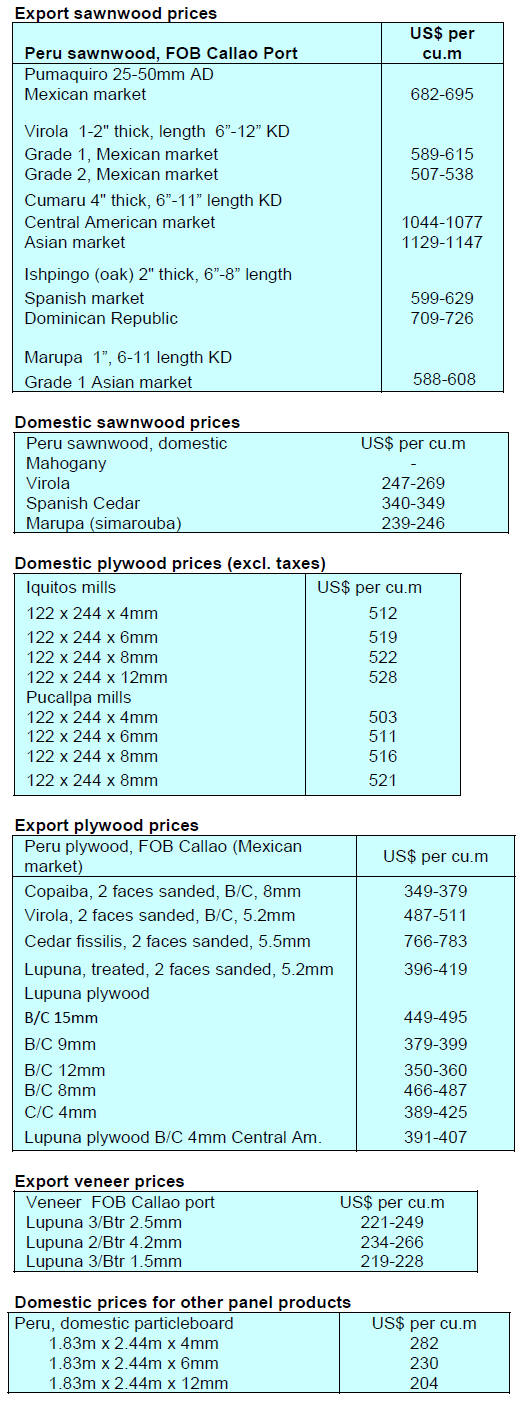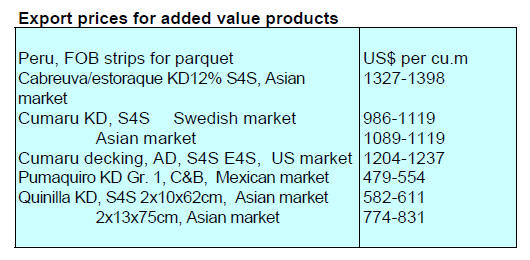4.
INDONESIA
IFCC accreditation becomes a
voluntary forestry
certification system
The National Accreditation Committee (KAN) officially
operates the Indonesian Forestry Certification Cooperation
(IFCC) accreditation as a voluntary forestry certification
scheme. IFCC is the first voluntary forestry certification
scheme operated by KAN. IFCC is the national governing
body of the international forestry scheme, the Programme
for the Endorsement of Forest Certification (PEFC).
The Secretary General of KAN, Donny Purnomo, said
KAN operates several international schemes for the
private sector adding that with an agreement with the
Ministry of Environment and Forestry KAN opened the
IFCC for sustainable forest management.
See:
https://www.beritasatu.com/news/940217/akreditasi-ifccresmi-jadi-sertifikasi-kehutanan-voluntary/2
Indonesian Wood Panel Association backs FOLU Net
Sink 2030
The Indonesian Wood Panel Association (Apkindo) has
backed the implementation of Indonesia's commitment to
FOLU Net Sink 2030.
The Chairman of Apkindo, Bambang Soepijanto, said
downstream producer members of Apkindo will take steps
so that sustainable forest management will play its role in
climate change mitigation.
Bambang said Apkindo will encourage its members to
increase the yield of wood so that the utilisation of this
raw materials is more efficient.
Apkindo is an organisation that accommodates industries
that produce veneers and plywood including laminated
veneer lumber (LVL), particleboard and other wood panel
products.
Currently, Apkindo has 45 active industry members that
contribute to the national export foreign exchange for
timber products of an average of 11.7 billion US dollars
per year.
See:
https://forestinsights.id/2022/06/10/dukung-indonesia-folunet-sink-2030-apkindo-bikin-langkah-strategis/
Digitalisation in support of sustainable forestry
development
Digitalisation can play a role in helping the forestry and
environmental sectors achieve the targets of Sustainable
Development Goals (SDGs) according to Siti Nurbaya
Bakar the Minister of Environment and Forestry. She
emphasised this during a virtual discussion on the
implementation of digitisation for achieving the SDG
targets organised by Think 20 (T20).
T20 is one of the engagement groups within the 2022
Indonesian G20 Presidency which aims to address global
problems through the application of ideas from scientists
and researchers across the world.
One example of digitisation carried out by the ministry is
the implementation of the National Forest Monitoring
System (SIMONTANA). The system provides information
regarding spatial-based forest resources data, hotspot
monitoring, forest and land fire surveillance as well as
water pollution monitoring.
See:
https://en.antaranews.com/news/234373/digitalization-vitalfor-sustainable-forestry-development-bakar
Support for peat land restoration and mangrove
rehabilitation
Indonesia is taking actions to restore peatland and
rehabilitate mangroves and this has attracted support from
the UK government which will consider support for
Indonesia through the Peat and Mangrove Restoration
Agency (BRGM).
Representatives of the UK government visited a location
of peatland restoration and mangrove rehabilitation in East
Mempawah, West Kalimantan.
In the future the UK government's support will be directed
towards peatland restoration and mangrove rehabilitation
activities at the BRGM in accordance with the Indonesia
FOLU Net Sink 2030 Operational Plan that has been
prepared.
In related news the Indonesian G20 Presidency is
encouraging the creation of a platform for the restoration
and rehabilitation of mangroves and peatlands according
to Sigit Reliantoro, co-chair of the Environment Deputies
Meeting and Climate Sustainability Working Group
(EDM-CSWG).
See:
https://agroindonesia.co.id/indonesia-lakukan-restorasigambut-dan-rehabilitasi-mangrove-inggris-siap-mendukung/
and
https://en.antaranews.com/news/234025/g20-ri-pushes-creationof-learning-platform-for-mangrove-restoration
Applications for commercialising environmental
services
The Ministry of Environment and Forestry (KLHK) has
received many applications for commercialising carbon
sequestration and storage.
The Director of Forest Utilisation at the Ministry of
Environment and Forestry said there is an opportunity in
the Job Creation Law where forestry businesses no longer
only be focused on timber and non-wood products but can
accommodate environmental services.
The Director revealed that harnessing environmental
services could be carried out in production and protected
forest areas. Even in forest areas that are included in the
Indicative Map for Postponed New Permits (PIPPIB).
The government has issued Presidential Regulation No. 98
of 2021 concerning the Economic Value of Carbon to
support the development of a business system for carbon
utilisation. The regulations for implementing this
provision are being prepared.
See:
https://forestinsights.id/2022/06/16/klhk-kebanjiranpermohonan-izin-pemanfaatan-jasa-lingkungan-regulasiperdagangan-karbon-segera-terbit/
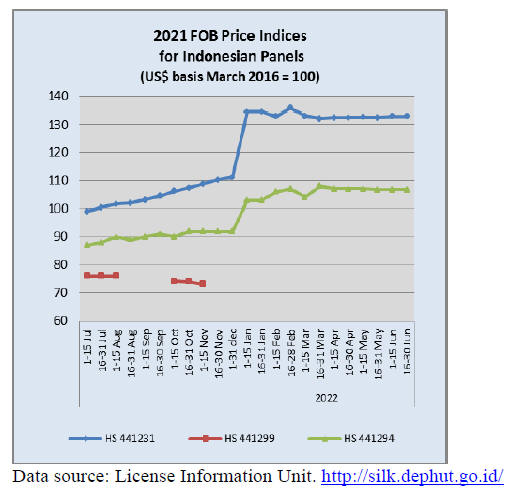
5.
MYANMAR
MTE to accept local currency as
payment for logs
The long-awaited solution, which took almost three
months to be announced, finally arrived. The Myanma
Timber Enterprise (MTE) will accept the local currency
(Kyat) as payment for logs.
After the Central Bank of Myanmar ordered all export
earnings to be converted within days into the domestic
currency the result was that millers could not purchase
logs as the MTE maintained its requirement that payments
must be in foreign currency.
Over the past three months all export earnings were
converted to Kyat but could not be used to pay for logs
from the MTE. MTE regulations stated the products from
the logs for which payment was made in foreign currency
could be exported while logs purchased in local currency,
generally lower grade logs, could only to be sold on the
domestic market.
It is understood that the Central Bank has set a fixed
exchange rate of MMK1850/US$ while the market rate is
around MMK2100/US$.
Substitution of Myanmar Teak
A US-based company, Teakdecking Systems in a press
release said they have identified a source of high quality
teak outside Myanmar. The press release says teak trees
are grown all around the world and can be found in
Central America, South America, Africa, and South East
Asia.
For decades the marine industry has claimed that the
highest quality of teak is only available from supplies
harvested in Myanmar and the industry became dependent
on this source believing no other source would do. Now
however, the company has found a source of high quality
teak from plantations that are FSC certified.
Action of Anti-illegal Trade Committee
According to the information released by the Myanmar
Anti-Illegal Trade Committee on 5 June over 14 million
kyats’ worth of illegal timber of various kinds along with
household goods were seized in the Yangon and Bago
Regions.
The Region Forest Department under the management of
Bago Region Anti-Illegal Trade Special Squad was on
inspection task on 3 June and seized about 3,750,120
kyats’ worth of 7.544 tons of illegal teak in the Toungoo
District and again on 4 June seized almost 5 million kyats’
worth of illegal timber weighing 13.9 tons.
See:
https://elevenmyanmar.com/news/illegal-timber-of-variouskinds-household-goods-worth-over-ks14-million-seized-inyangon-bago
World Bank unable to forecast growth
The World Bank has declined to issue growth forecasts for
Myanmar beyond fiscal 2021 saying the economy has
contracted so sharply since the military coup on Feb. 1,
2021 that the outlook remains fragile owing to sharply
higher input prices, recurring electricity outages,
escalating conflict and the recent introduction of trade and
foreign exchange restrictions.
6.
INDIA
Wholesale price indices for May 2022
The Office of the Economic Adviser, Department for
Promotion of Industry and Internal Trade has published
wholesale price indices for May 2022. The index for
manufactured products increased to 144.8 in May 2022
from 144.0 in April.
The annual rate of inflation rose 15.9% in May 2022
compared to May 2021. The inflation rate in May 2022
was high due to increased prices of petroleum and natural
gas, food, basic metals, non-food articles, chemical
products compared to the corresponding month of 2021.
Out of the 22 NIC two-digit groups for manufactured
products, 19 groups have witnessed increased prices while
3 groups saw a decline. The indices for both sawnwood
and veneer sheets increased sharply.
See:
https://eaindustry.nic.in/pdf_files/cmonthly.pdf

Bullish demand for particleboard
Plyreporter says particleboard manufacturers have seen
strong demand from furniture makers since the beginning
of the year. Problems with deliveries of imported board,
along with limits on the supply of domestic raw materials,
are said to be behind this change in demand. There are
more than 60 particleboard producers in India and they
report full ordrebooks.
The orders are especially firm from big commercial
companies which are back to full operation and the extra
demand from e-commerce and tech start-ups is also
helping drive demand.
See:
https://www.plyreporter.com/article/92982/officereadymade-furniture-helping-particle-boards-demand
Prices for recent shipments of teak logs and
sawnwood
Freight rates continue to be high. Shipments from Ghana,
Brazil and South Sudan have been quite active.

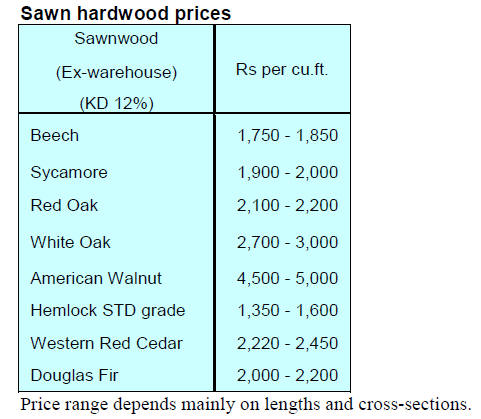
Plywood
Please note plywood prices are now shown free of local
taxes.
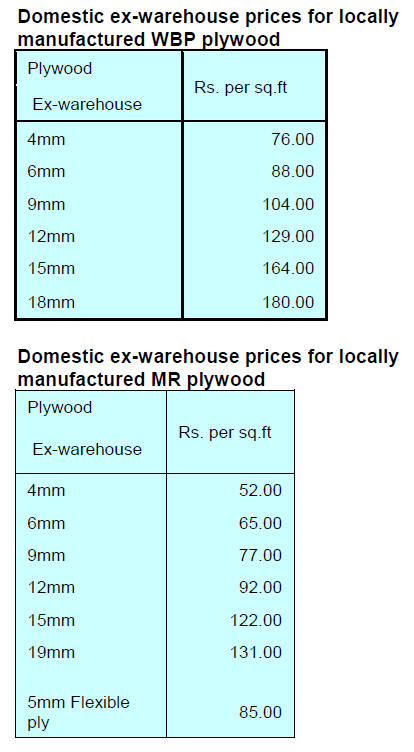
Non-brand furniture 50% of Indian market
According to a report prepared by Grand View Research,
an Indian and U.S. based market research and consulting
company quoted by the Business Standard, about 95% of
the non-brand furniture in India is manufactured by small
companies and non-brand furniture accounts for more than
50% of the India market.
As the Indian economy recovers demand for furniture is
expanding fast and demand for wooden furniture, seen as
environmentally-friendly, is popular among buyers of
readymade furniture. Non-brand furniture makers utilise
timber raw materials from Nepal, Malaysia and some
African countries along with domestic timbers.
Along with other manufacturing sectors, labour shortages
especially of skilled workers, is a constant problem as
skilled workers are attracted by higher earnings to be made
working outside of India in the Middle East and Malaysia
for example.
See:https://www.tbsnews.net/economy/industry/non-brandfurniture-industry-growing-eying-huge-exports-432710
And
https://www.grandviewresearch.com/
7.
VIETNAM
Wood and product trade highlights
According to the General Department of Customs wood
and wood product (W&WP) exports to Canada in May
2022 reached US$21.5 million, up 4% compared to May
2021. Overall, in the first five months of 2022 exports of
W&WP to the Canadian market reached US$111.2
million, up 6.3% over the same period in 2021.
W&WP exports to the UK in May 2022 reached US$8.4
million, down 35% compared to May 2021. In the first
five months of 2022 W&WP exports to the UK market
reached US$119.2 million, down 1% compared to the
same period of 2021.
Vietnam's wood imports in May 2022 reached 34,5000
cu.m, worth US$12.6 million, up 29% in volume and
28% in value compared to April 2022. Compared to May
2021 imports increased by 52% in volume and 51% in
value.
In the first 5 months of 2022 wood imports reached
121,400 cu.m, worth US$45.9 million, up 3% in volume
and 1.4% in value over the same period in 2021.
Imports of log and sawn wood from Africa in April 2022
reached 80,610 m3 at a value of US$30.34 million, up
3% in volume and 7% in value compared to March 2022
and up 0.8% in volume and 8.0% in value compared to
April 2021.
In the first four months of 2022 imports of wood from
Africa reached 346,460 cu.m at a value of US$27.17
million, up 3% in volume and 7% in value over the same
period in 2021.
Imports of African logs and sawnwood rising
Due to a decline in supply of wood from the US and the
EU and the souring prices for these two suppliers
Vietnamese importers have increased imports from Africa
despite the associated risks of illegality.
Although some African countries have certain areas of
certified forests and some levels of forest governance, the
supply of timber from Africa is complex and risky for the
Vietnamese wood industry.
In the first 4 months of 2022 Africa was the largest
supplier of timber for Vietnam. With the newly issued
Strategy for Forestry Development 2021-2022 and the
vision to 2050 and more recently the National Project on
Development of the wood Processing Industry 2021-2030
the Government has acted to eliminate illegally sourced
timber from the supply chain.
Importers have to intensify due diligence, submit more
evidence of timber legality and practice countermeasures
if risks are discovered.
Suppliers
In April 2022 imports of timber from Cameroon increased
sharply rising eight fold compared to March 2022 reaching
40,420 cu.m at a value of US$17.55 million, up 83% in
volume and 701% in value over March 2022 and up 35%
in volume and 341% in value compared to April 2021.
Over the first 4 months of 2022 imports of timber from
Cameroon amounted to 176,310 cu.m at a value of
US$4.52 million, up 21% in volume and 26% in value
over the same period of 2021.
Imports of logs from Cameroon in April increased
sharply reaching 27,390 cu.m, with a value of US$11.34
million, up 137% in volume and 114% in value compared
to March 2022 and up 56% in volume and 53% in value
compared to April 2021.
In the first four months of 2022 imports of log and
sawnwood from Cameroon increased compared to the
same period in 2021. The imports of sawnwood, in
particular reached 70,000 cu.m at a value of US$31.92
million, 72% up in volume and 74% in value.
Nigeria ranked second among African suppliers of logs
and sawnwood to Vietnam in April 2022, reaching
13,370 cu.m at a value of US$3.84 million, down 19 in
volume and 22% in value compared to March 2022 but
up by 15% in volume and 20% in value compared to
April 2021.
In the first four months of 2022 imports of log and
sawnwood from Nigeria totalled 48,070 cu.m at a value
of US$13.68 million, up 571% in volume and 65% in
value over the same period in 2021.
In contrast to these two major suppliers imports from
South Africa, Algeria, Gabon and The Republic of Congo
in the first 4 months of 2022 dropped compared to the
same period in 2021.
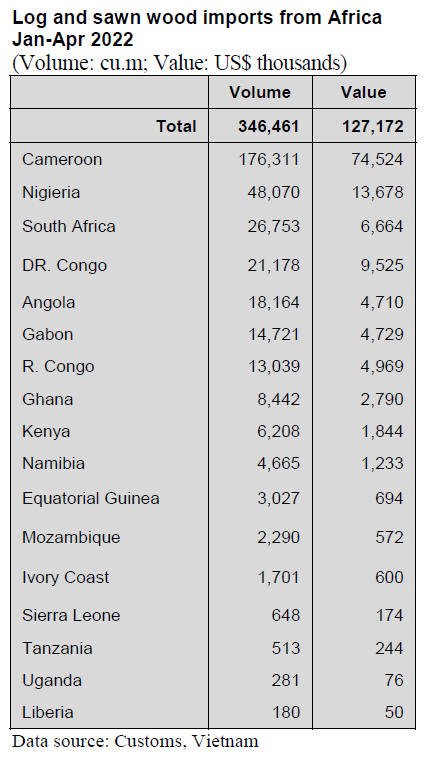
Prices
The average price of logs imported from Africa to
Vietnam in April 2022 stood at US$360/cu.m, up 0.4%
compared to March 2022; up 0.3% compared to April
2021. In the first 4 months of 2022 the average price of
logs from Africa to Vietnam stood at Ú$358/cu.m, down
1.1% compared to the same period in 2021.
The average price of sawnwood imported from Africa to
Vietnam in April 2022 stood at US$403/cu.m, up 11%
compared to March 2022; up 18% compared to April
2021. In the first 4 months of 2022 the average price of
sawnwood from Africa stood at US$378/cu.m, an
increase of 11% over the same period in 2021.
Tali, padauk and doussie topped the list of imported
sawnwood from Africa to Vietnam in the first 4 months of
2022. Import of tali and doussie increased significantly
while the import of padauk fell.
Vietnam to grant FLEGT licence to wood exports in
2025
Vietnam plans to grant licences under the Voluntary
Partnership Agreement on Forest Law Enforcement,
Governance and Trade Program (VPA/FLEGT) to W&WP
exports in 2025.
This FLEGT schedule was announced at a 17 June
workshop held jointly by the the Vietnam Forestry
Administration (VNFOREST), the Vietnam Timber and
Forest Products Association (VIFOREST) and the
Association of Handicraft and Wood Industry of
HCM City (HAWA).
At the event the co-chairs pointed out that, despite an
annual double-digit growth rate, the country’s wood
industry is still facing numerous challenges.
Apart from the pandemic escalating political tensions have
created more challenges to supply chains, soaring logistics
costs and material prices have resulted in higher input
costs. Inflation in key export markets has led to a drop in
demand. Accusations of material origin fraud also
threaten industry development.
To cope with these challenges the government urged
domestic businesses to adhere to international market
regulations, enhance their capacity and improve
competitiveness so as to maintain their foothold in wooden
furniture exports.
Echoing this view a HAWA spokesperson said
compliance with regulations on sustainable forestry
development is vital to the wood industry, not only for
Vietnam but also global markets.
At the workshop the HAWA platform for proving and
tracing wood origin was launched.
With support from the FAO-EU FLEGT Programme since
May 2018 HAWA has worked to remove obstacles in
wood origin validation. This is a necessary step to prepare
Vietnamese timber and wood products to access
international markets, especially the EU.
By applying HAWA system everyone can search for
information to help verify the material origin.
See:
https://vietnamnews.vn/economy/1252720/viet-nam-togrant-flegt-licence-to-wood-exports-in-2025.html
Struggling with global uncertainties
With full order books Vietnamese manufacturers are
facing huge challenges in terms of raw material supply,
production costs and logistics.
HAWA has identified that the industry is still facing many
challenges due to Covid-19 disruptions and geopolitical
uncertainties.
The price of raw materials is high even though 70% of the
material for Vietnam's wood furniture industry is
domestically sourced. Logistics prices show no signs of
cooling down and are even rising due to the Russian
invasion of Ukraine.
At present, Vietnam's wood enterprises that want to keep
their markets must overcome the situation together by
stabilising product prices.
See:
https://theinvestor.vn/wood-processing-firms-struggle-amidglobal-uncertainties-d584.html
8. BRAZIL
Innovations in the Amazon forest
resource
management
At an event themed "Federal Forest Management Systems
- Procedures and Controls" the Brazilian Institute of
Environment and Natural Resources (IBAMA) presented
progress of its main regulatory, technical and control tool
related to the sustainable production chain for forest
products from natural forests.
The agenda covered topics such as: the techniques for
reduced impact logging through Sustainable Forest
Management Plans (SFMP); traceability controls for forest
products through the Federal systems of SINAFLOR+
(National System to Control the Origin of Forest Products)
and DOF (Document of Forest Origin)+Traceability) with
emphasis on the functioning of the Wood Management
Analytical Panels (part of the Forest+Wood Platform /
Plataforma Floresta+Madeira).
The event made an important contribution to the debate
around legal timber production with regard to security and
guarantees of the origin of products from forest
management areas. In addition there was a presentation on
the chain of custody and the timber control mechanisms.
According to IBAMA the dialogue with representatives
from the main importing countries allowed an interaction
and provided an opportunity for a better understanding of
the permit procedures for forestry activities based on
controls and audits of IBAMA.
According to the Mato Grosso Center for Timber
Production and Exporting Industries (CIPEM) the debate
enabled the clarification of several points related to the
sustainability of the forest activity and the importance of
the conservation of the Amazon.
See:
https://cipem.org.br/noticias/inovacoes-a-gestao-dosrecursos-florestais-e-apresentada-a-diplomatas
Forest conservation in the Amazon
Rural producers in the Carajás region in the state of Pará
in the Amazon region have been searching the Amazon
rainforest for seeds of native tree species.
Over the last three years around 17 tonnes of seeds have
been collected and in the process this has provided more
than R$2.8 million in income for rural families. This
initiative is a partnership between Vale and the
Cooperative of Extractivists of Carajás’ Flona (Coex).
The work of the cooperative members also increases the
knowledge about the diversity of the Amazon with
training for the identification and mapping of mother trees.
In the germplasm rescue process (seed collection) the
flowering, fruiting and seed dispersal cycle is also
followed, which contributes to guarantee the variety and
seeds´ quality, as they are vital to the forest restoration
chain.
According to the specialist in Forest Restoration from the
Federal University of Viçosa, the production of seedlings
for forest restoration and the chain of seed production will
generate timber and non-timber goods such as nuts,
palmhearts, fruits, which will enable the
commercialization generating income for small producers.
According to Coex these collected seeds are for promoting
biodiversity conservation and for keeping the forest
standing, for the recovery of degraded areas and
permanent preservation areas and guaranteeing the
conservation of the Amazon. The activity generated work
and income for families undertaking the collection.
See:
https://agenciabrasil.ebc.com.br/geral/noticia/2022-06/diamundial-do-meio-ambiente-reforca-conservacao-das-florestas
Export update
In May 2022 exports of wood-based products (except pulp
and paper) increased 21% in value compared to May 2021,
from US$416.2 million to US$503.2 million.
Pine sawnwood exports grew significantly by 27% in
value between May 2021 (US$66.5 million) and May
2022 (US$4.6 million). In volume however, exports were
flat at 298,100 cu.m compared to to 295,200 cu.m in May
2021.
Tropical sawnwood exports increased around 7% in
volume, from 41,200 cu.m in May 2021 to 43,900 cu.m in
May 2022. In value, exports grew 13% from US$6.6
million to US$18.8 million, over the same period.
Pine plywood exports saw a 20% decline in value in May
2022 compared to May 2021, from US$127.7 million to
US$101.6 million. In volume, exports also decreased 3%
over the same period, from 247,100 cu.m to 239,200 cu.m.
As for tropical plywood, exports decreased in volume (-
9%) but increased in value
(6%), from 6,500 cu.m (US$3.2 million) in May 2021 to
5,900 cu.m (US$3.4 million) in May 2022.
Disappointingly, wooden furniture export earning dropped
from US$69.7 million in May 2021 to US$58.9 million in
May 2022, an almost 16% fall.
Brazil/US unprecedented growth in trade
According to the Brazilian-American Chamber of
Commerce (AMCHAM Brasil) in the first quarter of 2022
bilateral trade between Brazil and the United States totaled
US$19 billion with unprecedented growth in trade
between the two countries.
In terms of states, trade between the state of Paraná
(southern region of Brazil) and the US recorded a growth
of almost 40% in the first three months of 2022 compared
to the same period of the previous year.
See:
https://forestnews.com.br/exportacoes-de-produtos-demadeira-brasileiros-crescem-22-em-abril/
The state's exports to the US had the highest value in the
historical series for a first quarter (equivalent to US$ 411.3
million), representing a 50% growth in total exports,
driven by sales of processed wood products (+47 %) and
pulp (+96%), among others.
Furniture sector targets international markets
The production of the furniture sector, both nationally and
in the state of Rio Grande do Sul (one of the furniture
clusters in Brazil) experienced a significant growth in
exports increasing 50% in 2021.
International sales jumped from US$487.6 million in 2020
to US 757.3 million in 2021 with Rio Grande do Sul state
representing one third of the total value in the period. A
positive result was job creation which reached 2,590 (an
increase of 140% in 12 months) that raised the number
employed in the sector to around 37,000, the highest
occupation recorded in the last five years by the furniture
sector.
The Orchestra Brazil project, in partnership with the
Brazilian Trade and Investment Promotion Agency (Apex-
Brasil), took 17 companies to the Interzum Fair, a major
fair for the furniture industries held in Colombia.
Colombia purchased US$150 million in Brazilian furniture
in 2021.
See:https://gauchazh.clicrbs.com.br/colunistas/martasfredo/noticia/2022/05/apos-explosao-de-demanda-na-pandemiasetor-moveleiro-do-rs-quer-continuar-em-altacl2xf68cs000w0167hfv01kyk.html
and
https://forestnews.com.br/projeto-orchestra-brasil-leva-industriamoveleira-a-feira-na-colombia/
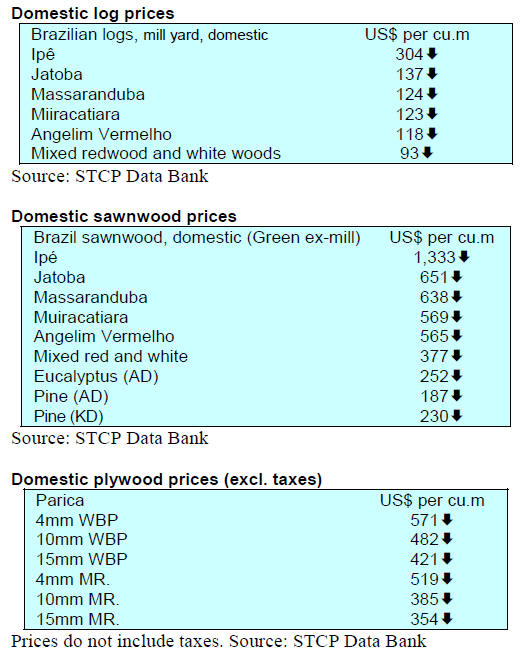

9. PERU
Imports of wooden furniture rise
In the first four months of 2022 the value of Peruvian
imports of wooden furniture was US$23.6 million, an
increase of 12% compared to the same period in 2021.
Brazil was, as usual, the main supplier shipping US$15.7
million which represented two thirds of the total imported.
The second largest supplier was China with US$4.9
million followed by Colombia which had the highest
growth rate in the period.
Imports of the two main home improvement chains in the
country represented 63% of the total imported wooden
furniture in the first four months of 2022 compared to
57.3% in the same period of 2021.
Commercial forest plantation development
The National Forest and Wildlife Service (Serfor) and the
World Bank will work together to develop initiatives that
promote reforestation and the establishment of forest
plantations.
The Executive Director of Serfor indicated that Serfor has
a new management model that has three very important
pillars: the Forest Investment Plan by 2050, the Quality
and Integrity Management System and the Investment
Project of the National Forest and Fauna Information
System, Wild (SNIFFS).
Strategic development of the forestry and wildlife
sectors
The Instituto de Investigaciones de la Amazonía Peruana
(IIAP) and Serfor will join forces to promote the strategic
development of the forestry sector.
In June this year Serfor and IIAP signed an interinstitutional
cooperation agreement with the aim of
promoting and implementing activities that support the
strategic development of the forestry and wildlife sector in
Peru.
The framework agreement ensures that Serfor, through the
Directorate of Studies and Research (DEI) of the General
Directorate of Forestry and Wildlife Policy and
Competitiveness and IIAP, through the Directorate of
Research on Comprehensive Forest Management and
Ecosystem Services, undertake collaborative actions
aimed at providing technical advice on issues related to the
execution of the National Forest and Wildlife Inventory
and the applied use of its results.
Recovery of wooden furniture exports
The Management of Services and Extractive Industries of
the Association of Exporters (ADEX) has reported that
exports of wooden furniture and parts in the first quarter of
the year totalled US$965,112, a year on year growth of
13% however, it still does not match the value of 2018
(January-March) exports which were just over
US$1,332,000
According to ADEX Data Trade commercial intelligence
figures the US imported US$0.8 million, representing 76%
of the total. Others were Chile (US$0.2 million), Italy
(US$96,000) and the United Arab Emirates (US$16,000).
Shipments were made to ten destinations.
The main item shipped was ‘other’ wooden furniture
(US$0.5 million), with a 47% share this included
sideboards, consoles, tables, coffee tables, shelves and
desks.
Manufacturers in Lima were the main exporters at US$0.8
million or 77% of total shipments. Others were Áncash
(US$100,000) and La Libertad (US$67,000).
In the first quarter of the year, wooden furniture and parts
ranked fourth among shipments of wood surpassed by
semi-manufactured products (US$22.1 million),
sawnwood (US$12.6 million) and fuelwood and charcoal
(US$1.1 million).
SERFOR management model to boost forest
production
In June the National Forest and Wildlife Service
(SERFOR) presented the new institutional management
model to those responsible for the Technical Forestry and
Wildlife administrations (ATFFS) and Functional Liaison
Units (UFE), at the workshop training and integration for
the development of strategies and strengthening of
institutional management.
The workshop was held in Lima and made possible the
identification of technical and administrative strategies.
The ‘Invest Forest 2050’ plan will promote the production
and competitiveness of the forest, forestry and wildlife
research, information and forest zoning and forest
governance.
